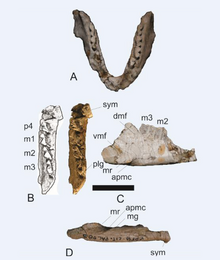| Prohegetotherium | |
|---|---|

| |
| Prohegetotherium fossilized lower mandibles. | |
| Scientific classification | |
| Domain: | Eukaryota |
| Kingdom: | Animalia |
| Phylum: | Chordata |
| Class: | Mammalia |
| Order: | †Notoungulata |
| Family: | †Hegetotheriidae |
| Subfamily: | †Hegetotheriinae |
| Genus: | †Prohegetotherium Ameghino 1897 |
| Species | |
| |
| Synonyms | |
| |
Prohegetotherium is an extinct genus of hegetotheriid notoungulates from the Late Oligocene to Early Miocene (Deseadan-Santacrucian in the SALMA classification) of the Agua de la Piedra,[1] Mariño & Sarmiento Formations of Argentina, the Petaca and Salla Formations of Bolivia, and Fray Bentos Formation of Uruguay.[2][3]
Taxonomy[edit]
Prohegetotherium comprises three species, P. sculptum, P. schiaffinoi, and P. malalhuense.[2] Although Prohegetotherium shumwayi and P. crassus have long been synonymized with P. sculptum, Kramarz and Bond (2017) restricted P. sculptum to the holotype, rejecting the synonymy.[4]
See also[edit]
References[edit]
- ^ Hernández Del Pino, Santiago; Seoane, Federico; Cerdeño, Esperanza (2022). "New craniodental information and taxonomic decisions of the typotherians (Notoungulata) from the late Oligocene of Mendoza, central-western Argentina". Acta Palaeontologica Polonica. 67. doi:10.4202/app.00974.2022. hdl:11336/202725. ISSN 0567-7920.
- ^ a b Prohegetotherium at Fossilworks.org
- ^ Reguero, Marcelo Alfredo; Tineo, David Eric; Bona, Paula; Pérez, Leandro Martín; Vergani, Gustavo Dardo; Ruiz, Gloria González; Poiré, Daniel Gustavo (2021-05-14). "A singular Hegetotheriinae (Notoungulata, Typotheria) from the late Oligocene-Early Miocene of the Subandean Region of Bolivia". Brazilian Journal of Geology. 51 (2). doi:10.1590/2317-4889202120200067. ISSN 2317-4889.
- ^ A. G. Kramarz and M. Bond. 2017. Systematics and stratigraphical range of the hegetotheriids Hegetotheriopsis sulcatus and Prohegetotherium sculptum (Mammalia: Notoungulata). Journal of Systematic Palaeontology 15(12):1027-1036









Well, that’s interesting to know that Psilotum nudum are known as whisk ferns. Psilotum nudum is the commoner species of the two. While the P. flaccidum is a rare species and is found in the tropical islands. Both the species are usually epiphytic in habit and grow upon tree ferns. These species may also be terrestrial and grow in humus or in the crevices of the rocks.
View the detailed Guide of Psilotum nudum: Detailed Study Of Psilotum Nudum (Whisk Fern), Classification, Anatomy, Reproduction